World Roundup
July/August 2017


-
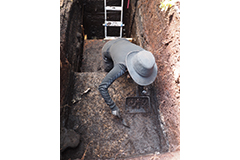 CANADA: Excavations on Triquet Island off the British Columbian coast may affirm the generations-old oral histories of the Heiltsuk Nation. Their tradition holds that tribal ancestors once sought refuge on an unfrozen strip of land along the coast to survive the last Ice Age. Radiocarbon dating of charcoal found in a hearth indicates that human settlement on the island dates back, surprisingly, some 14,000 years, when most of Canada was covered in glaciers. The site also holds evidence of stone tool manufacture and sea mammal hunting. —Jason Urbanus
CANADA: Excavations on Triquet Island off the British Columbian coast may affirm the generations-old oral histories of the Heiltsuk Nation. Their tradition holds that tribal ancestors once sought refuge on an unfrozen strip of land along the coast to survive the last Ice Age. Radiocarbon dating of charcoal found in a hearth indicates that human settlement on the island dates back, surprisingly, some 14,000 years, when most of Canada was covered in glaciers. The site also holds evidence of stone tool manufacture and sea mammal hunting. —Jason Urbanus -
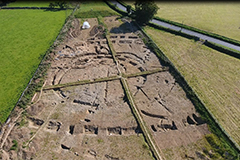 IRELAND: A previously unknown early medieval ringfort measuring 130 feet in diameter was discovered near Roscommon during a road construction project. Occupied between the 6th and 11th centuries, it served a variety of purposes over that time. Initially, it was likely home to a prominent family, but was later transformed into a jewelry workshop, an animal enclosure, and a cemetery when the original inhabitants expanded their settlement into the surrounding countryside. Around 800 burials were also identified, including 470 belonging to juveniles and infants. —Jason Urbanus
IRELAND: A previously unknown early medieval ringfort measuring 130 feet in diameter was discovered near Roscommon during a road construction project. Occupied between the 6th and 11th centuries, it served a variety of purposes over that time. Initially, it was likely home to a prominent family, but was later transformed into a jewelry workshop, an animal enclosure, and a cemetery when the original inhabitants expanded their settlement into the surrounding countryside. Around 800 burials were also identified, including 470 belonging to juveniles and infants. —Jason Urbanus -
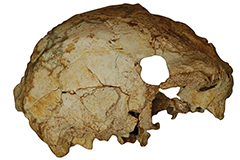 PORTUGAL: A 400,000-year-old partial skull buried in the Gruta da Aroeira cave in central Portugal is the oldest human fossil ever found in Portugal and the westernmost in Europe dating to the Middle Pleistocene. The deposit in which the cranium was embedded also contains stone tools, faunal remains, and burned bones. Because the skull displays a unique combination of physical characteristics, experts are hoping it can provide important new information about human evolution in Europe and the origins of Neanderthals. —Jason Urbanus
PORTUGAL: A 400,000-year-old partial skull buried in the Gruta da Aroeira cave in central Portugal is the oldest human fossil ever found in Portugal and the westernmost in Europe dating to the Middle Pleistocene. The deposit in which the cranium was embedded also contains stone tools, faunal remains, and burned bones. Because the skull displays a unique combination of physical characteristics, experts are hoping it can provide important new information about human evolution in Europe and the origins of Neanderthals. —Jason Urbanus -
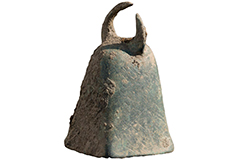 CORSICA: A sanctuary dedicated to the god Mithras has been excavated at the Roman site of Mariana. Within the multiroom complex archaeologists have recovered parts of the customary relief sculpture depicting the god slaying a sacred bull, as well as bronze bells, oil lamps, and other ceramics used during religious ceremonies. Mithraism was a mystery religion that was introduced to Rome from the East and gained popularity in the late first century A.D., especially with the Roman military. —Jason Urbanus
CORSICA: A sanctuary dedicated to the god Mithras has been excavated at the Roman site of Mariana. Within the multiroom complex archaeologists have recovered parts of the customary relief sculpture depicting the god slaying a sacred bull, as well as bronze bells, oil lamps, and other ceramics used during religious ceremonies. Mithraism was a mystery religion that was introduced to Rome from the East and gained popularity in the late first century A.D., especially with the Roman military. —Jason Urbanus -
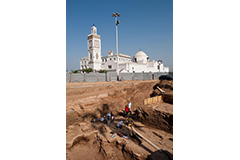 ALGERIA: Nearly 2,000 years of Algerian history is being exposed during ongoing construction of a new metro station in Martyrs Square in Algiers. Although authorities knew the site was located near the Roman port of Icosium, they were overwhelmed by the trove of artifacts, mosaics, and infrastructure belonging to the Byzantine, Ottoman, and French colonial periods. The 32,000-square-foot site was deemed so significant that the government has now adapted their plans for the metro line in order to accommodate and preserve it. —Jason Urbanus
ALGERIA: Nearly 2,000 years of Algerian history is being exposed during ongoing construction of a new metro station in Martyrs Square in Algiers. Although authorities knew the site was located near the Roman port of Icosium, they were overwhelmed by the trove of artifacts, mosaics, and infrastructure belonging to the Byzantine, Ottoman, and French colonial periods. The 32,000-square-foot site was deemed so significant that the government has now adapted their plans for the metro line in order to accommodate and preserve it. —Jason Urbanus -
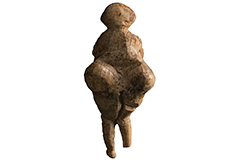 RUSSIA: An extraordinary 23,000-year-old figurine was unearthed in the Bryansk region of western Russia alongside stone tools, painted mammoth bones, and bison remains. The tiny two-inch statuette is carved from mammoth tusk and represents a possibly pregnant woman, rendered with exaggerated proportions. She is one of only a few existing small Paleolithic sculptures known as Venus figurines, thought to embody an ancient, idealized concept of femininity. Experts believe they may have served ritual or ceremonial purposes, perhaps associated with fertility. —Jason Urbanus
RUSSIA: An extraordinary 23,000-year-old figurine was unearthed in the Bryansk region of western Russia alongside stone tools, painted mammoth bones, and bison remains. The tiny two-inch statuette is carved from mammoth tusk and represents a possibly pregnant woman, rendered with exaggerated proportions. She is one of only a few existing small Paleolithic sculptures known as Venus figurines, thought to embody an ancient, idealized concept of femininity. Experts believe they may have served ritual or ceremonial purposes, perhaps associated with fertility. —Jason Urbanus -
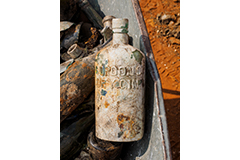 ISRAEL: Archaeologists recently gained new insight into the leisure activities of British soldiers stationed in Israel during WWI. The construction of a highway near Ramla uncovered a former British military barracks, which contained thousands of discarded objects dating to the period. As expected, military paraphernalia and other reflections of soldierly life were found, but workers also came across hundreds of glass liquor bottles that once held wine, beer, whiskey, and gin that had been imported from Europe to supply the troops. —Jason Urbanus
ISRAEL: Archaeologists recently gained new insight into the leisure activities of British soldiers stationed in Israel during WWI. The construction of a highway near Ramla uncovered a former British military barracks, which contained thousands of discarded objects dating to the period. As expected, military paraphernalia and other reflections of soldierly life were found, but workers also came across hundreds of glass liquor bottles that once held wine, beer, whiskey, and gin that had been imported from Europe to supply the troops. —Jason Urbanus -
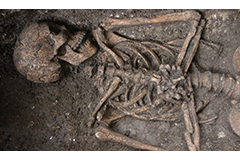 TAIWAN: Until recently, little was known about the Spanish colony of San Salvador de Isla Hermosa, which was founded on Heping Dao in 1626. However, current work is finally exposing parts of the early settlement, including the foundations of a church or convent and an adjacent cemetery. One of the burials, an adult male with his hands folded in prayer, is believed to be the earliest European Christian-style interment in the Asia-Pacific region. —Jason Urbanus
TAIWAN: Until recently, little was known about the Spanish colony of San Salvador de Isla Hermosa, which was founded on Heping Dao in 1626. However, current work is finally exposing parts of the early settlement, including the foundations of a church or convent and an adjacent cemetery. One of the burials, an adult male with his hands folded in prayer, is believed to be the earliest European Christian-style interment in the Asia-Pacific region. —Jason Urbanus -
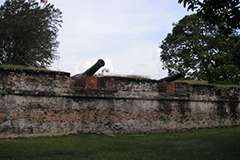 MALAYSIA: An area that was once part of the moat that surrounded Fort Cornwallis in George Town proved to contain an array of artifacts dating back to the colonial era, including coins, porcelain, ceramics, plates, and glasses. The fort was originally built in 1793 at the behest of the British East India Company, and the moat was added in 1804 for extra security against a possible French attack. It was filled in during the 1920s to curb mosquito breeding during a malaria outbreak. —Jason Urbanus
MALAYSIA: An area that was once part of the moat that surrounded Fort Cornwallis in George Town proved to contain an array of artifacts dating back to the colonial era, including coins, porcelain, ceramics, plates, and glasses. The fort was originally built in 1793 at the behest of the British East India Company, and the moat was added in 1804 for extra security against a possible French attack. It was filled in during the 1920s to curb mosquito breeding during a malaria outbreak. —Jason Urbanus -
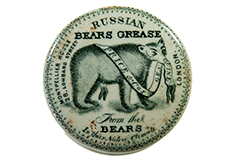 NEW ZEALAND: The site of a future convention center in Christchurch is shedding light on the lives of the city’s first European settlers. Apparently, even back then, men were concerned with hair loss. Among the hundreds of artifacts found at the site in rubbish pits and deposits dating to the mid-19th century was a container of Russian Bears Grease. The quirky pharmaceutical product purportedly aided hair growth and prevented baldness—the underlying theory being that because bears were hairy, their fat could stimulate hair growth for humans. —Jason Urbanus
NEW ZEALAND: The site of a future convention center in Christchurch is shedding light on the lives of the city’s first European settlers. Apparently, even back then, men were concerned with hair loss. Among the hundreds of artifacts found at the site in rubbish pits and deposits dating to the mid-19th century was a container of Russian Bears Grease. The quirky pharmaceutical product purportedly aided hair growth and prevented baldness—the underlying theory being that because bears were hairy, their fat could stimulate hair growth for humans. —Jason Urbanus
Advertisement
IN THIS ISSUE
From the Trenches
Ka-Ching!
Off the Grid
While You Are Waiting
A Dangerous Island
House Rules
Renaissance Melody
Take Me Out to the Ball Game
Tomb Couture
Not So Pearly Whites
Late Paleolithic Masterpieces
Afterlife on the Nile
Knight Watch
The Grand Army Diet
Angry Birds
World Roundup
First World War booze, Russian bear grease, Mediterranean mystery religion, and exploring under Algiers
Artifact
A venerable bead
Advertisement

Recent Issues
-
 May/June 2024
May/June 2024
-
 March/April 2024
March/April 2024
-
 January/February 2024
January/February 2024
-
 November/December 2023
November/December 2023
-
 September/October 2023
September/October 2023
-
 July/August 2023
July/August 2023
-
 May/June 2023
May/June 2023
-
 March/April 2023
March/April 2023
-
 January/February 2023
January/February 2023
-
 November/December 2022
November/December 2022
-
 September/October 2022
September/October 2022
-
 July/August 2022
July/August 2022
-
 May/June 2022
May/June 2022
-
 March/April 2022
March/April 2022
-
 January/February 2022
January/February 2022
-
 November/December 2021
November/December 2021
-
 September/October 2021
September/October 2021
-
 July/August 2021
July/August 2021
-
 May/June 2021
May/June 2021
-
 March/April 2021
March/April 2021
-
 January/February 2021
January/February 2021
-
 November/December 2020
November/December 2020
-
 September/October 2020
September/October 2020
-
 July/August 2020
July/August 2020
-
 May/June 2020
May/June 2020
-
 March/April 2020
March/April 2020
-
 January/February 2020
January/February 2020
-
 November/December 2019
November/December 2019
-
 September/October 2019
September/October 2019
-
 July/August 2019
July/August 2019
-
 May/June 2019
May/June 2019
-
 March/April 2019
March/April 2019
-
 January/February 2019
January/February 2019
-
 November/December 2018
November/December 2018
-
 September/October 2018
September/October 2018
-
 July/August 2018
July/August 2018
-
 May/June 2018
May/June 2018
-
 March/April 2018
March/April 2018
-
 January/February 2018
January/February 2018
-
 November/December 2017
November/December 2017
-
 September/October 2017
September/October 2017
-
 July/August 2017
July/August 2017
-
 May/June 2017
May/June 2017
-
 March/April 2017
March/April 2017
-
 January/February 2017
January/February 2017
-
 November/December 2016
November/December 2016
-
 September/October 2016
September/October 2016
-
 July/August 2016
July/August 2016
-
 May/June 2016
May/June 2016
-
 March/April 2016
March/April 2016
-
 January/February 2016
January/February 2016
-
 November/December 2015
November/December 2015
-
 September/October 2015
September/October 2015
-
 July/August 2015
July/August 2015
-
 May/June 2015
May/June 2015
-
 March/April 2015
March/April 2015
-
 January/February 2015
January/February 2015
-
 November/December 2014
November/December 2014
-
 September/October 2014
September/October 2014
-
 July/August 2014
July/August 2014
-
 May/June 2014
May/June 2014
-
 March/April 2014
March/April 2014
-
 January/February 2014
January/February 2014
-
 November/December 2013
November/December 2013
-
 September/October 2013
September/October 2013
-
 July/August 2013
July/August 2013
-
 May/June 2013
May/June 2013
-
 March/April 2013
March/April 2013
-
 January/February 2013
January/February 2013
-
 November/December 2012
November/December 2012
-
 Sep/Oct 2012
Sep/Oct 2012
-
 September/October 2012
September/October 2012
-
 July/August 2012
July/August 2012
-
 May/June 2012
May/June 2012
-
 March/April 2012
March/April 2012
-
 January/February 2012
January/February 2012
-
 November/December 2011
November/December 2011
-
 September/October 2011
September/October 2011
-
 July/August 2011
July/August 2011
-
 May/June 2011
May/June 2011
-
 March/April 2011
March/April 2011
-
 January/February 2011
January/February 2011
Advertisement






